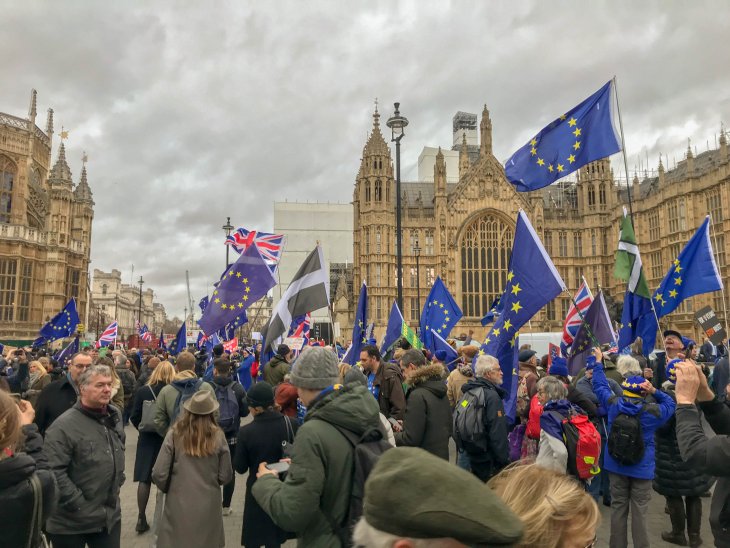Like every peace settlement, the Good Friday Agreement is a compromise document, the result of a long and difficult bargaining process that should be properly understood.

Photo: Martin Hearn via Flickr
Perhaps not a “cracking read”, to use the words of former Brexit Secretary Dominic Raab, but the Good Friday Agreement has been a pillar for the peace in Northern Ireland since 1998.
Understanding the Good Friday Agreement is central to Brexit negotiations, a peaceful future in Northern Ireland and UK-Ireland relations. The first steps to understanding any document must be based on thorough reading. The success and support for the Good Friday Agreement deserves this, and not necessarily “over the holidays”. In such negotiations and uncertain times, equally important as reading the agreement is considering what people in Northern Ireland think about this agreement.
Sadly, Raab’s comments illustrate that neither a careful reading nor consideration of local perceptions is present in current debates.
Like every peace settlement, the Good Friday Agreement is a compromise document, the result of a long and difficult bargaining process. The provisions necessary for the warring parties to put down their weapons, such as amnesties, are not always popular among the population in whose name the agreement is signed. Yet central to the success of a peace agreement is local support.
As part of a comparative research project on “Attitudes for Peace”, we conducted a public opinion survey in Northern Ireland around the time of the Brexit referendum (between May and July 2016). The survey provides a window into people’s attitudes towards the Good Friday Agreement at that crucial time.
Despite the agreement’s shortcomings, it generally has widespread support. Importantly, the survey also shows that people of Northern Ireland continue to be concerned about a return to the violence of the past and that society continues to be divided along communal lines.
Among the 800 survey respondents, 89 per cent felt that the peace agreement was necessary to end the conflict and 84 per cent felt it reflected the will of the people of Northern Ireland. Asked whether they were satisfied with the peace process, 74 per cent agreed.
The Good Friday Agreement has been hailed as a model for peace agreements, which is reflected in the overall high levels of support it enjoys. Yet peace is still fragile, threatened both by communal divides and – as the recent failed attacks in Derry show – persistent violence.
Though about half expressed some concern that the agreement had not been implemented properly – and even more people may have come to feel this way in the last two years, given the absence of a functioning power-sharing government – the survey showed generally positive attitudes to the agreement in both communities.
Some provisions are more divisive than others. Reflecting the major fault lines of the conflict, one of the divisive issues in the agreement – although overall strongly supported – is the provision stating that Northern Ireland should remain part of the UK if the majority of the population so wishes. Another divisive clause was the early release of paramilitary prisoners.
The architects of the Good Friday Agreement never sought to resolve the political differences that led to the conflict directly. Instead, the hope was that a return to peaceful politics and political discourse would, in time, lead to coexistence and reconciliation. The concern today is that the divisions from the Troubles will be reinforced by the prospects of a hard border and the fact that the peace agreement seems to be up for grabs.
The most obvious divides remain physical. The Catholic and Protestant communities are highly segregated, especially in poorer and urban areas. Nothing has come to represent communal divisions more than the interfaces and so-called peace walls, several of which were built since 1998. The walls are supposed to come down by 2023, but the survey shows that the share of the population that still think them necessary (38 per cent) is just as big as that supporting their dismantlement (40 per cent). Insecurity remains.
The survey shows that people were particularly supportive of the security brought by disarmament – in both communities. Indeed, the vast majority wants to move on from the conflict, yet the survey also highlights people’s fear of renewed violence. A large minority saw political violence (41 per cent) and the risk of new armed conflict (36 per cent) as a big problem.
The Good Friday Agreement has been hailed as a model for peace agreements, which is reflected in the overall high levels of support it enjoys. Yet peace is still fragile, threatened both by communal divides and – as the recent failed attacks in Derry show – persistent violence.
The Good Friday Agreement is not perfect, as demonstrated by high levels of violence and segregation in Northern Ireland. Despite this, it has been instrumental in ending the conflict and ensuring peace for two decades. Brexit negotiators – past, present and future – must not only read the document, but do their utmost to understand the fears and hopes of a divided society.
- Kristin M. Bakke’s research for this piece was supported by a grant from the Norwegian Research Council. It is part of a collaborative project on “Attitudes for Peace,” with Karin Dyrstad (Norwegian University of Science and Technology), Helga Malmin Binningsboe (Peace Research Institute Oslo), and Arne Henning Eide (the Foundation for Scientific and Industrial Research at the Norwegian Institute of Technology). Prof. Bakke is affiliated with the Peace Research Institute Oslo.
- Kit Rickard receives PhD-funding from the Economic and Social Research Council (ESRC).
- This piece originally occurred at The Independent, which you can read here. A version of it also appeared at The Conversation, under the title ‘Why changing the Good Friday Agreement because of Brexit is such a dangerous idea‘.